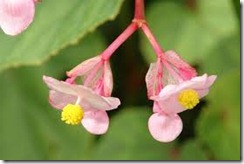Tuberous begonias, available in hanging, and, upright varieties, can be replanted and recovered annually by storing the tubers during cold winter months. These perennials, often treated as annuals, are available in both tuberous and rhizome species. Although their appearance is similar, tubers are stored differently than rhizomes, so be sure to check labels before storing for the winter.
Differences Between Tuberous and Rex Variety Begonias
-
The difference between tuberous begonias and the rhizome (or, rex) varieties of begonnia, is visually difficult to identify. Some popular tuberous standards include Double Trumpet, Prima Donna and Hanging Sensation. Available colors include white, yellow, red, and peach with frilly, carnation-like, rose, or double flowering blooms. Tubers are shorter and thicker than rhizomes and do not lengthen much as they grow. Unlike tubers, rhizomes are stored in a humid environment, in a recommended ½ peat ½ perlite soil mix.
End of Season Care
-
Tuberous begonias flower in summer and fall, thriving best in a rich, well-drained soil in filtered sunlight. East exposure is often best for successful plant growth and development. During the blooming season, water your begonias regularly and watch for milky residue (begonias are susceptible to powdery mildew). At the end of the blooming season, and when the plant leaves begin to turn yellow, back off watering completely and allow the plant to dry out. When stems fall off easily on their own, pull the tuber out of the ground and shake off the dirt. Leave tubers in the sun, on an upside-down flat layered with newspaper, for about three days to completely dry the tuber and prevent rotting.
Store Tubers in a Shed or Garage
-
Store tubers in a cool, dry, area with broken shade, like a shed or a bottom shelf of the garage. Be sure the tubers are completely dry and remove any still moist plant parts or tubers before storing. Dr. Leonard Perry, from the University of Vermont Extension Office, advises that you dust the tubers with anti-fungal or sulfur powder to discourage mold, rot or other plant disease.
Cover Tubers with Leaf Mold
-
Store tubers on a flat, covered with an inch to two inches of leaf mold or organic matter. Water regularly throughout the winter until begonia tubers begin to show signs of small, pink buds, in mid to late February.
Spring Repotting and Replanting
-
When begonias show signs of budding in late winter or early spring, it is time to move them. Repot begonia tubers in an 8 to 10 inch pot filled with fast-draining, rich, humous soil, using a ready-made soil mix for African Violets, or, other flowering houseplants. Or, mix your own soil by adding perlite, peat and/or leaf mold to a lesser soil mixture. Keep new plants in broken shade and fertilize weekly with a high-nitrogen fertilizer until about mid May. Switch during peak season to a bloom-producing fertilizer. Water begonias regularly, keeping moist but well drained, until end of season.


Deprecated: strpos(): Passing null to parameter #1 ($haystack) of type string is deprecated in /home/agriviek8Qv/agriviet.net/public_html/wp-includes/comment-template.php on line 2522